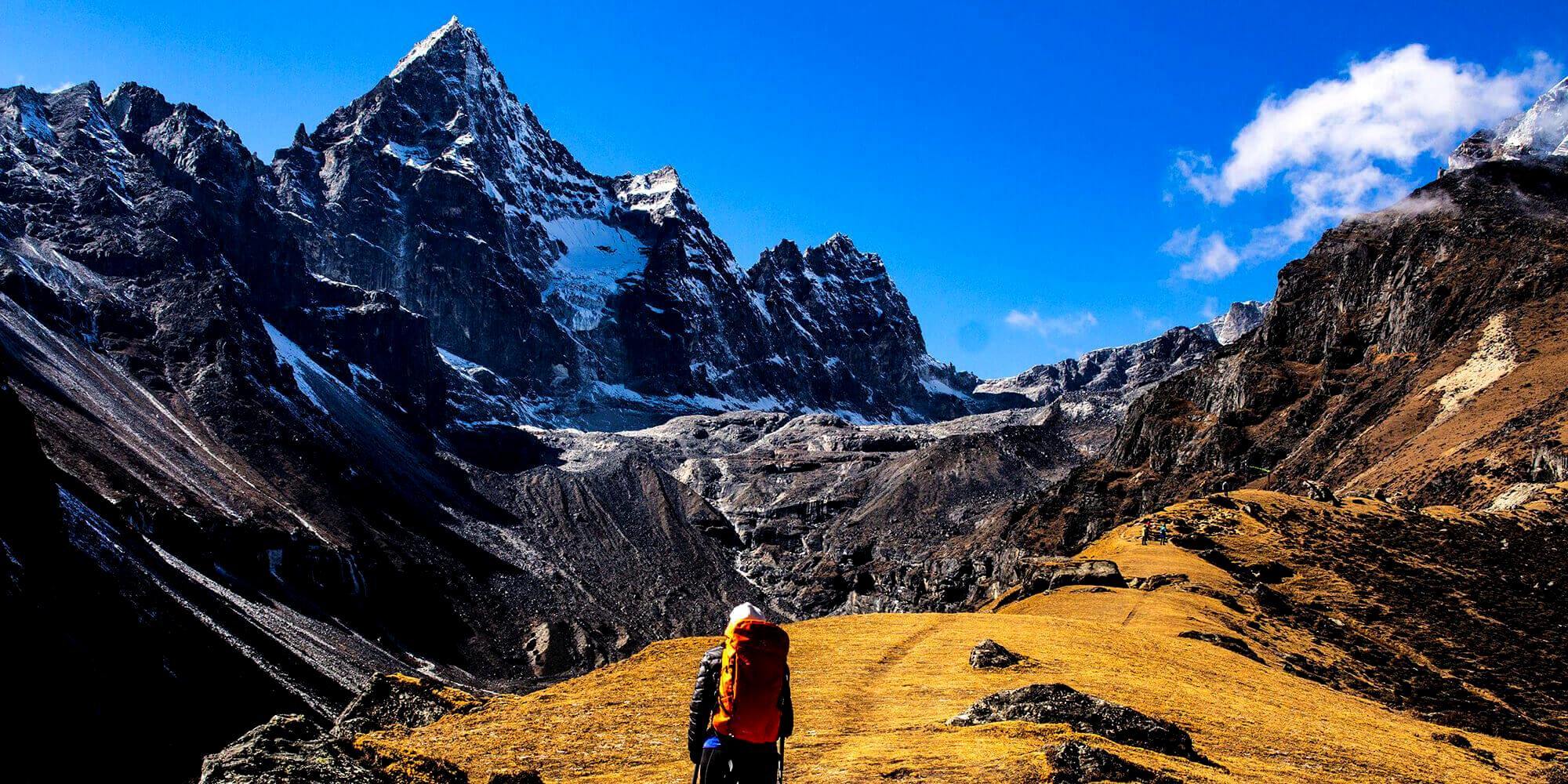When is the winter in Nepal?
Winter in Nepal typically spans from December to February. During these months, the weather is generally cold, especially at higher altitudes, with clear skies and reduced precipitation, making it a popular time for trekking due to the excellent visibility of the Himalayan peaks.
Ghorepani Poonhill Winter Trek
The Ghorepani Poonhill Winter Trek is one of the most popular short treks in the Annapurna region of Nepal, renowned for its accessibility and spectacular panoramic views of the majestic Himalayan peaks. Here’s a detailed look at what makes this trek a must-do during the winter season:
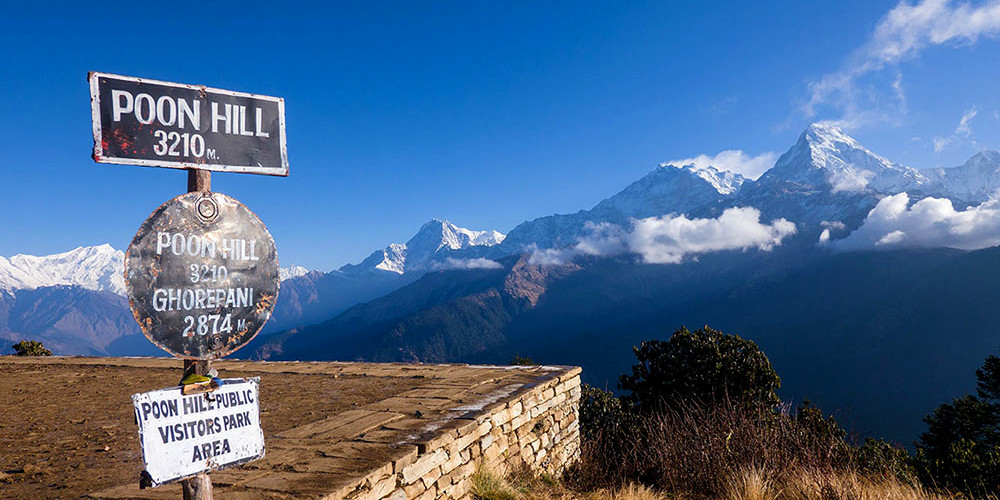
Overview
- Duration: Typically 4-5 days Difficulty: Moderate Start/End: Pokhara Maximum Altitude: Poon Hill at 3,210 meters (10,531 feet)
Highlights
-
Stunning Mountain Views: The trek offers unrivaled views of the Annapurna and Dhaulagiri ranges, including peaks like Machhapuchhre (Fishtail), Annapurna South, and Nilgiri. The highlight is the sunrise from Poon Hill, where the sun lights up the mountains in hues of orange and red.
-
Rhododendron Forests: In the winter, the rhododendron forests are often dusted with snow, creating picturesque winter wonderland scenes, though the trees are not in bloom as they are in spring.
-
Cultural Experience: The trek passes through small villages and communities of the Gurung and Magar people, offering trekkers a glimpse into the rural life of ethnic communities in Nepal.
Trek Route: The trek usually starts from Nayapul, a short drive from Pokhara, and follows a path through Tikhedhunga to Ulleri. From Ulleri, the trail leads to Ghorepani, passing through dense forests of oak and rhododendrons which may be snow-covered in winter. The ascent to Poon Hill is typically undertaken early in the morning of the following day to catch the spectacular sunrise. After enjoying the views, trekkers descend back to Ghorepani, and then head towards Tadapani and finally to Ghandruk or Jhinu Danda, completing a loop before heading back to Nayapul.
Winter Considerations
-
Weather: Temperatures during the winter can drop below freezing at night, especially at higher altitudes. Days are usually clear and sunny.
-
Preparation: It’s crucial to be well-prepared with appropriate winter gear. Essential items include thermal clothing, a good quality sleeping bag rated for cold temperatures, insulated boots, and layers to handle the cold.
-
Safety: Trails can be slippery if there is snow or ice, so trekking poles and possibly microspikes can be very helpful.
-
Services: While the Ghorepani Poonhill trek is well-traveled and the tea houses remain open in winter, it’s always a good idea to check in advance for any changes in service availability during the off-season months.
Ghorepani Poonhill trek during winter allows trekkers to enjoy the quiet and solitude of the off-peak season, with the added beauty of snowy landscapes, making it an ideal choice for those looking for a short but rewarding Himalayan experience.
Khopra Ridge Remote Trek
The Khopra Ridge Remote Trek is a lesser-known gem in the Annapurna region of Nepal, offering trekkers a more secluded and intimate experience with the Himalayas compared to the often crowded traditional routes. This trek is an excellent choice for those seeking solitude and stunning natural beauty, along with an immersive cultural experience.
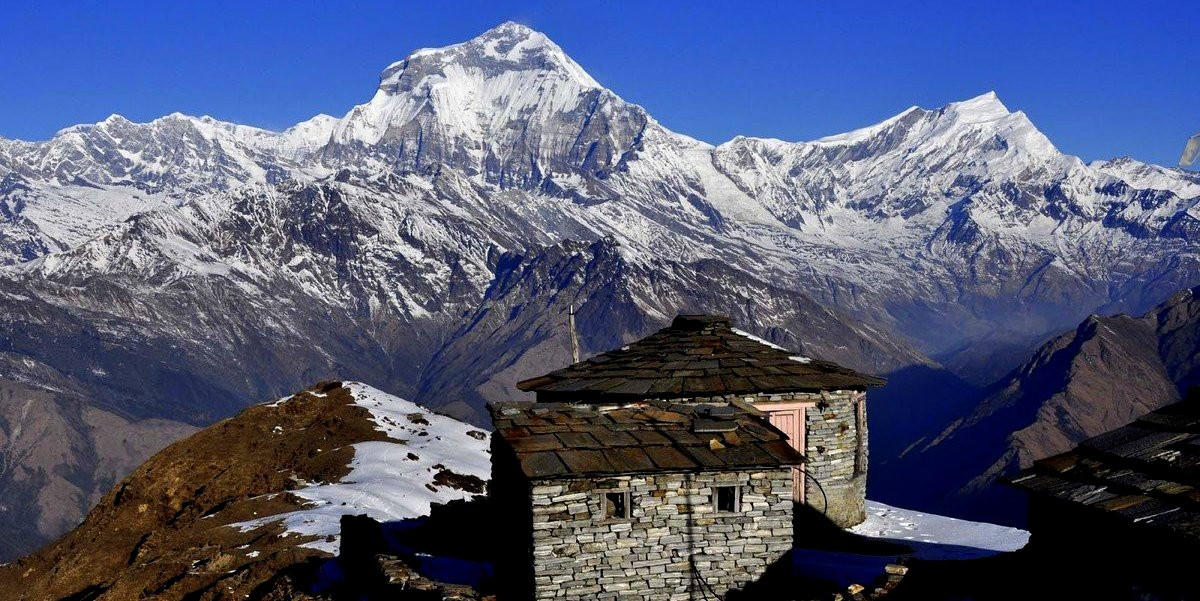
Overview
- Duration: Approximately 7-10 days Difficulty: Moderate to Challenging Start/End: Pokhara Maximum Altitude: Khopra Danda at 3,660 meters (12,007 feet)
Highlights
-
Stunning Panoramas: The highlight of the trek is the panoramic view from Khopra Ridge, which includes close-up views of Mt. Dhaulagiri, Annapurna South, Fang, and Nilgiri.
-
Kaire Lake: For those willing to extend their trek, a visit to the sacred Kaire Lake, located at a higher altitude near Khopra Ridge, adds a spiritual and adventurous element to the journey.
-
Community-Based Lodging: The Khopra Ridge trek supports community-based tourism with lodges and guesthouses run by the local communities, providing a direct benefit to the local economy.
Trek Route: The trek typically starts from Nayapul, a short drive from Pokhara, following the same initial route as the popular Ghorepani Poonhill trek. Trekkers diverge at Tadapani to enter less frequented trails leading to Dobato and then to Khopra Danda. The return route can include a visit to the holy Kaire Lake, adding an additional day or two to the itinerary, before descending to Swanta Village and eventually back to Nayapul.
Winter Considerations
-
Weather: Winter weather at Khopra Ridge can be harsh, with snow and colder temperatures, particularly at night. It’s essential to be prepared for sub-zero temperatures.
-
Preparation: Good quality, cold-weather gear is necessary, including layers, a down jacket, insulated sleeping bags, and possibly snow gear depending on recent conditions.
-
Safety: Navigation can be more challenging under snow cover, and the risk of avalanches, though low, should be considered. Hiring a local guide is highly recommended due to the remote nature of this trek.
-
Services: Fewer trekkers and limited open teahouses mean it’s crucial to plan logistics carefully and check which guesthouses are operating during the winter months.
Cultural Interaction: The trek passes through various Magar and Gurung villages, providing trekkers with an opportunity to experience the daily lives and cultural practices of these ethnic groups. Interaction with local communities offers insights into traditional farming, local cuisine, and the vibrant culture of the region.
The Khopra Ridge Remote Trek is a fantastic option for those looking to explore the Annapurna region's natural beauty away from the more crowded trails, offering a deep connection with nature and local Nepalese culture. This trek not only challenges the body but also enriches the spirit, making it a must-do for avid trekkers seeking a profound Himalayan experience.
Everest View Winter Hiking
The Everest View Winter Hiking is a fantastic option for those who wish to experience the magnificence of the world’s highest peaks without embarking on the more strenuous and lengthy Everest Base Camp trek. This trek provides breathtaking views of Mount Everest and its surrounding giants while being accessible and relatively easier, making it a popular choice during the winter months when the skies are clearest.
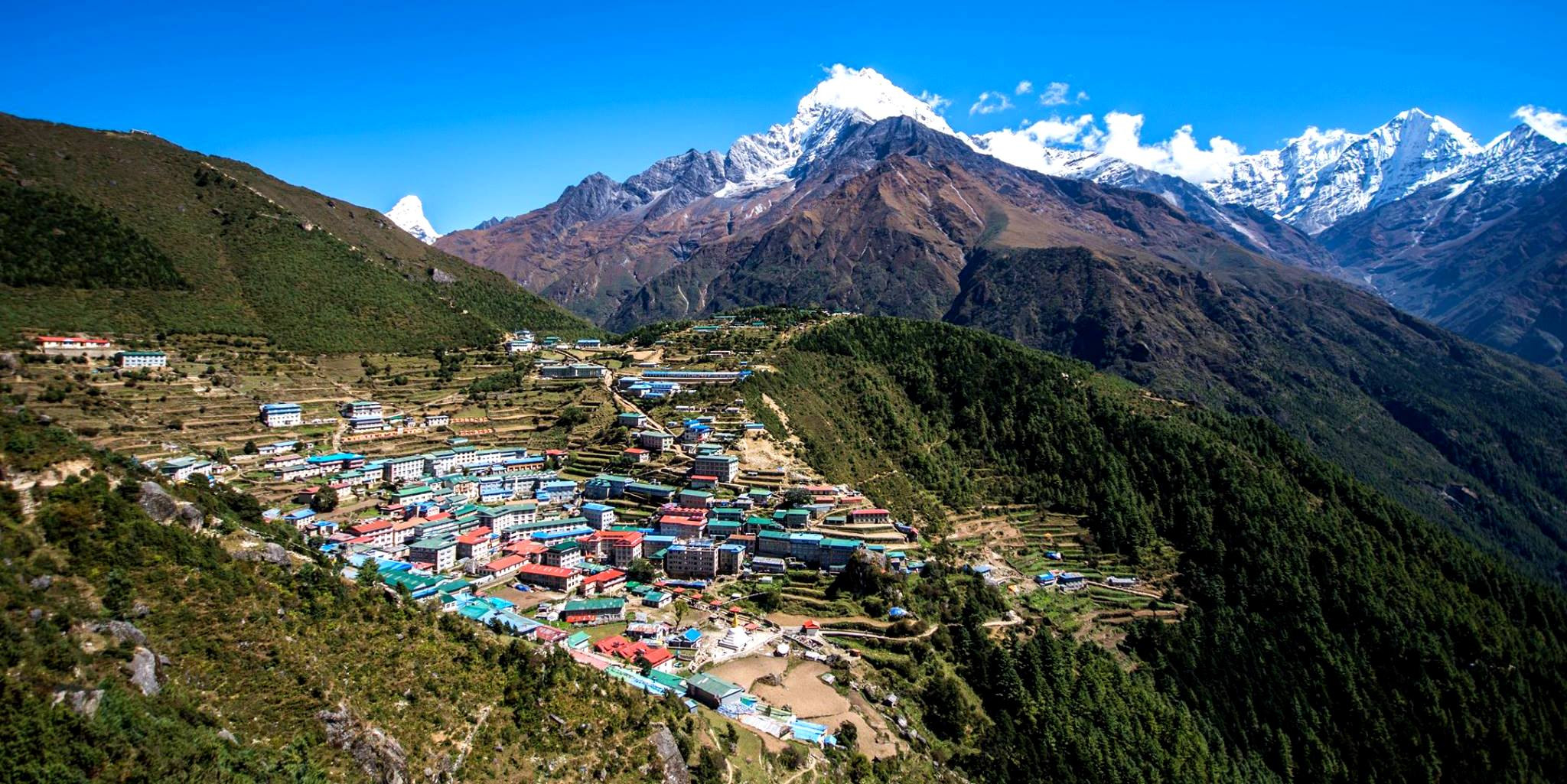
Overview
- Duration: 5-7 days Difficulty: Moderate Start/End: Lukla Maximum Altitude: Hotel Everest View at 3,880 meters (12,730 feet)
Highlights
-
Spectacular Mountain Views: Enjoy stunning panoramic views of Mount Everest, Lhotse, Ama Dablam, and other peaks from viewpoints like Hotel Everest View, one of the highest-placed hotels in the world.
-
Sherpa Culture and Villages: The trek passes through iconic Sherpa villages such as Namche Bazaar, Khumjung, and Tengboche, offering a deep dive into the rich cultural heritage of the Khumbu region.
-
Tengboche Monastery: Visit this famous Buddhist monastery, which is a spiritual center for the Sherpa community and offers awe-inspiring views of the surrounding mountains.
Trek Route: The trek begins with a scenic flight from Kathmandu to Lukla, the gateway to the Everest region. From Lukla, trekkers proceed to Phakding and then ascend to Namche Bazaar, the bustling hub of the Khumbu region. After acclimatizing in Namche, the trail continues to the village of Khumjung and then on to Tengboche, home to the revered Tengboche Monastery. The return route typically follows the same path back to Lukla.
Winter Considerations
-
Weather: Winter in the Everest region is cold with temperatures often dropping below freezing, especially at night. However, the days are usually sunny, dry, and clear, offering the best mountain views with fewer clouds.
-
Preparation: Proper gear is crucial for a comfortable trek; this includes thermal clothing, a good quality down jacket, warm sleeping bags, and sturdy hiking boots.
-
Safety: Trails may be icy; using trekking poles for stability is recommended. Although the paths are well-traveled, always be aware of the weather conditions and potential hazards like frostbite.
-
Services: Most teahouses and lodges remain open during the winter months, but it’s wise to confirm accommodations in advance as some might close depending on the severity of the season.
Cultural Interaction: The trek provides ample opportunities to interact with the local Sherpa people and learn about their lifestyle and traditions. Many trekkers find the cultural aspect as rewarding as the physical trek itself, gaining insights into the resilience and hospitality of the high Himalayan communities.
The Everest View Winter Hiking is an ideal choice for those looking to experience the beauty of the Everest region with less physical demand and more comfort, making it perfect for a wide range of trekkers, including families and those with limited time.
Langtang Valley December Trek
The Langtang Valley December Trek offers a unique and serene trekking experience, providing stunning views of snow-capped mountains and a chance to explore the distinct culture of the Tamang people in the Langtang region. This trek is especially appealing in December when the landscape is beautifully adorned with snow, and the paths are less crowded, allowing for a more tranquil experience.
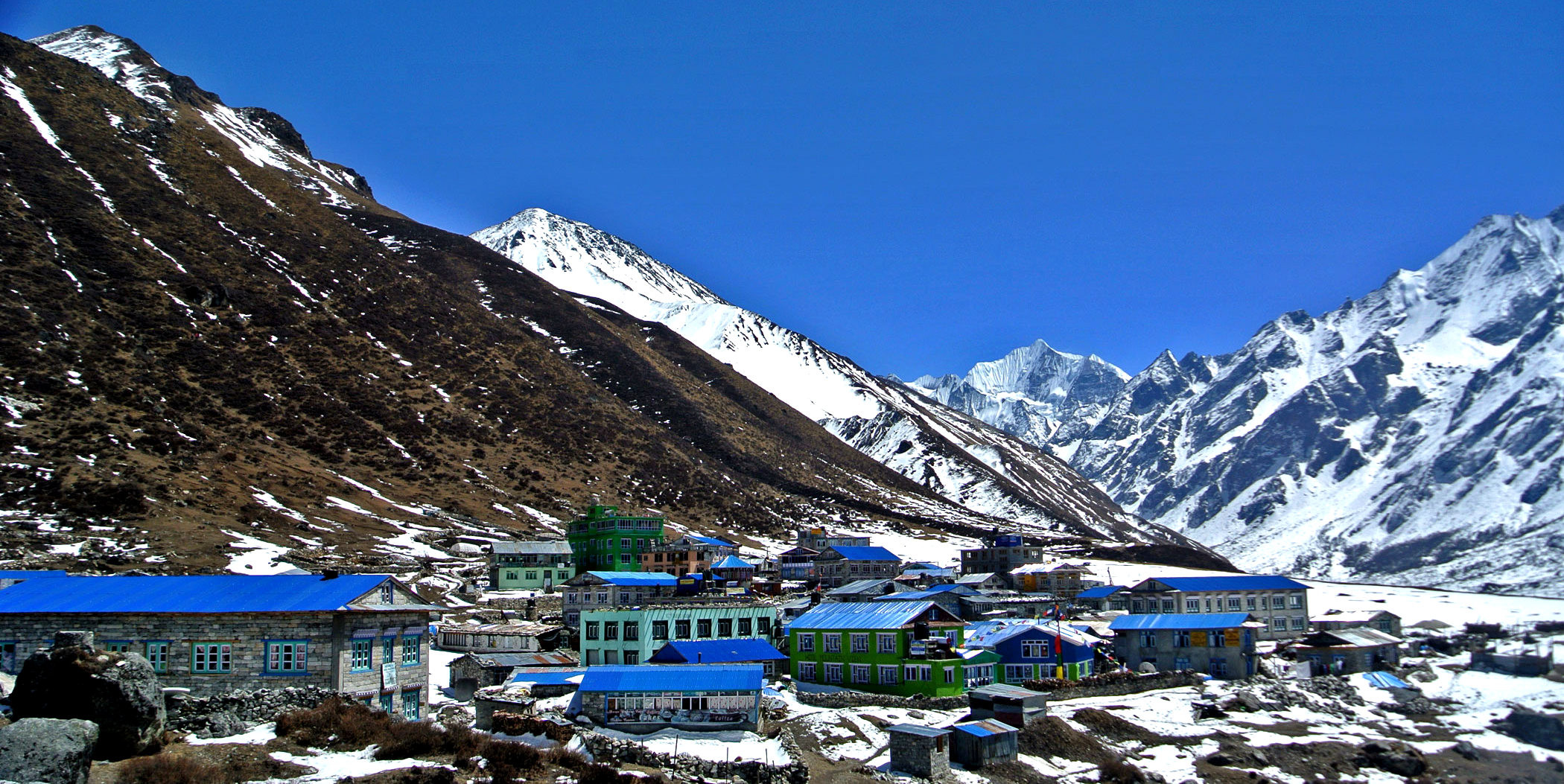
Overview
- Duration: 7-9 days Difficulty: Moderate Start/End: Syabrubesi Maximum Altitude: Kyanjin Gompa at 3,870 meters (12,697 feet)
Highlights
-
Scenic Landscapes: The trek features a variety of landscapes, including lush forests, rugged cliffs, and expansive views of Langtang Lirung and other Himalayan peaks.
-
Kyanjin Gompa: A small Buddhist monastery in the village of Kyanjin, which is also a great base for short hikes to further viewpoints, including the climb to Tserko Ri for panoramic views.
-
Tamang Culture: Immerse yourself in the rich cultural heritage of the Tamang community, experiencing their hospitality, cuisine, and traditions.
Trek Route: The trek starts with a drive from Kathmandu to Syabrubesi, the gateway to the Langtang Valley. From Syabrubesi, trekkers ascend through forests of oak and rhododendron, entering the Langtang National Park, home to diverse wildlife including the rare red panda. The route continues through Lama Hotel, Langtang village, which was rebuilt after the 2015 earthquake, and finally reaches Kyanjin Gompa. Trekkers often spend a day in Kyanjin Gompa to acclimatize and explore the surrounding area, including a possible hike to Tserko Ri for exceptional mountain views. The return trek follows the same route back to Syabrubesi.
Winter Considerations
-
Weather: December in the Langtang Valley can be cold, with daytime temperatures hovering around freezing and nights much colder. The weather is generally stable with clear blue skies providing excellent visibility.
-
Preparation: It’s essential to have suitable winter gear, including insulated boots, layers of thermal clothing, a warm sleeping bag, and perhaps even snowshoes depending on the snow level.
-
Safety: Snow and ice can make some parts of the trail slippery, so trekking poles and crampons might be necessary. It’s also important to be cautious of potential avalanches in certain areas.
-
Services: Fewer trekkers mean fewer open teahouses, so it’s crucial to plan accordingly. However, those that are open can provide a cozy, intimate experience with greater interaction with hosts.
Cultural Interaction: The Langtang Valley trek is not just about the landscapes but also about cultural engagement. Visiting in December allows trekkers to see local life in the winter, which includes unique insights into how the communities prepare for and survive the colder months. There may also be an opportunity to participate in or witness local winter activities and traditions.
The Langtang Valley December Trek is an excellent choice for trekkers looking to enjoy a quieter path with stunning winter scenery and deep cultural experiences, making each step in the snow a moment to cherish.
Dhampus Sarangkot Panoramic Views Trek
The Dhampus Sarangkot Panoramic Views Trek is an excellent choice for those looking for a short and relatively easy trek that offers some of the most spectacular panoramic views of the Annapurna range. This trek is particularly popular among families and those with limited time who still want to experience the magic of the Himalayas up close. During the winter months, the trek provides a serene atmosphere with crystal-clear skies and frosty landscapes.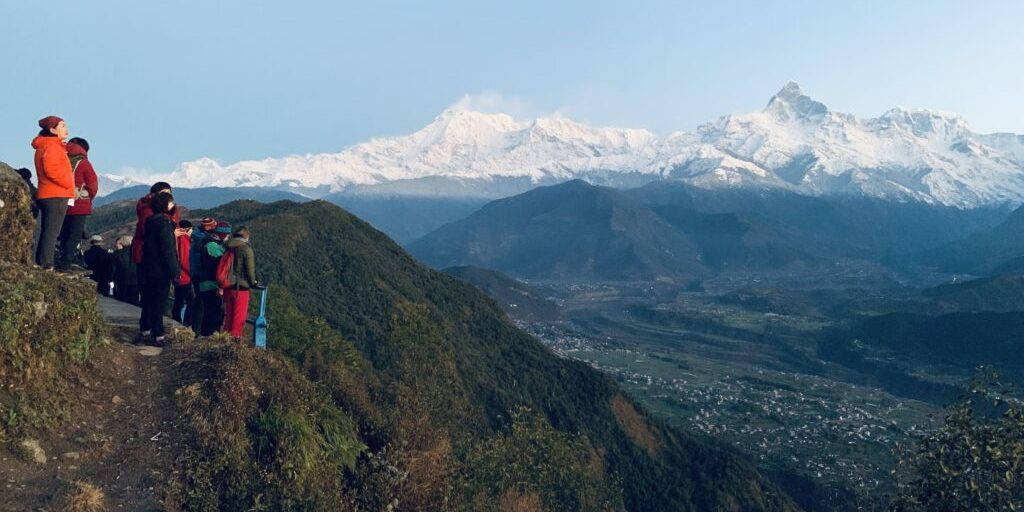
Overview
- Duration: 3-4 days Difficulty: Easy Start/End: Pokhara Maximum Altitude: Sarangkot at 1,600 meters (5,249 feet)
Highlights
-
Stunning Mountain Views: Enjoy breathtaking views of the Annapurna Massif, Dhaulagiri, Manaslu, and Machhapuchhre (Fishtail Mountain).
-
Charming Villages: Walk through picturesque villages like Dhampus and Naudanda, experiencing the hospitality and culture of the local Gurung and Brahmin communities.
-
Sarangkot Sunrise and Sunset: Sarangkot is famed for its sunrise and sunset views over the Himalayas, providing spectacular photo opportunities and unforgettable moments.
Trek Route: The trek usually starts with a short drive from Pokhara to Phedi, from where you begin your walk up to Dhampus. This beautiful village offers stunning views of the Annapurna range and is an excellent place for an overnight stay. From Dhampus, the trail leads to Naudanda and then to Sarangkot, a popular viewpoint for observing both sunrise and sunset over the mountains. The trek concludes with a descent back to Pokhara, either on foot via the scenic route or by vehicle from Sarangkot.
Winter Considerations
-
Weather: The weather is cooler, especially in the mornings and evenings, but the days are usually sunny, making for pleasant trekking conditions. Night temperatures can drop, so warm clothing is essential.
-
Preparation: While the trek is not strenuous, appropriate winter gear such as warm clothing, a comfortable pair of walking boots, and a good quality sleeping bag (if staying in basic lodges) will enhance comfort.
-
Safety: The paths are well-trodden and not typically icy, but morning frost can make some spots slippery, so walking poles can be helpful.
-
Services: The teahouses and lodges along this route are generally well-equipped and remain open during the winter, catering to trekkers with warm Nepalese hospitality.
Cultural Interaction: The trek passes through villages inhabited by Gurung and Brahmin people, offering trekkers an insight into the rural lifestyle of Nepal’s hill communities. Interaction with locals provides a deeper understanding of their daily lives, traditional practices, and the warm hospitality that characterizes Nepalese culture.
The Dhampus Sarangkot Panoramic Views Trek is perfect for those seeking a brief yet rich Himalayan experience without the commitment required for longer, more arduous treks. Its accessibility from Pokhara and the combination of natural beauty and cultural richness make it a rewarding choice for a quick winter getaway.
Useful Tips for Top 5 Best Winter Trek in Nepal
Trekking in Nepal during the winter months can be an incredibly rewarding experience, offering clear skies, quieter trails, and the stunning beauty of snow-capped mountains. However, winter trekking also comes with its own set of challenges. Here are some useful tips to help you make the most of the top 5 best winter treks in Nepal:
Proper Gear and Clothing
-
Layering: Wear multiple layers of clothing to manage body heat effectively. Include a base layer that wicks away sweat, an insulating layer for warmth, and a waterproof outer layer to protect against wind and snow.
-
Footwear: Use sturdy, waterproof trekking boots with good ankle support. Make sure they are well-broken-in to avoid blisters.
-
Accessories: Don't forget hats, gloves, and scarves. Consider thermal gloves and a balaclava or face mask for higher altitudes or particularly cold days.
Acclimatization and Altitude Sickness
-
Take it slow: Ascend gradually to give your body time to adjust to higher altitudes. This is crucial to prevent altitude sickness.
-
Stay hydrated: Cold weather can reduce your thirst response, but dehydration makes you more susceptible to altitude sickness. Keep drinking water throughout your trek.
Travel Insurance
- Make sure your travel insurance covers high-altitude trekking and potential helicopter evacuation. Verify that it provides coverage specific to the activities and altitudes you will be encountering.
Hire a Guide or Porter
- Hiring a local guide or porter can enhance your trekking experience. Guides provide valuable information about the culture and geography of the area, while porters can help carry your gear, allowing you to focus on the hike and scenery.
Check Weather Conditions Regularly
- Winter weather in the mountains can be unpredictable. Regularly check weather forecasts and be prepared to adjust your plans accordingly to avoid any dangerous weather conditions.
Prepare for Shorter Daylight Hours
- Winter days are shorter, so plan to start your hikes early to make the most of the daylight. This also provides a buffer in case you move slower than expected or need to make unplanned stops.
Packing Essentials
-
Sun Protection: The sun can be particularly intense in snowy environments, so bring sunglasses, sunscreen, and lip balm with high SPF.
-
Headlamp: Essential for early starts or late finishes, a headlamp will be invaluable on shorter winter days.
-
Thermal Sleeping Bag: Night temperatures can drop significantly, so a good quality thermal sleeping bag is essential for a comfortable sleep.
Respect Local Customs and Culture
- When visiting remote villages and interacting with local communities, be respectful of their customs, traditions, and privacy. Dress modestly, ask permission before taking photographs, and contribute to the local economy by purchasing local goods and services.
Emergency Preparedness
- Carry a basic first aid kit, know the symptoms of altitude sickness, and have a plan for getting back to safety in case of an emergency. Satellite phones or GPS trackers are recommended for remote treks.
By following these tips, you can ensure a safer, more enjoyable winter trekking experience in Nepal, making the most of what these spectacular trails have to offer.
Health and Safety for Top 5 Best Winter Trek in Nepal
When planning a winter trek in Nepal, prioritizing health and safety is crucial due to the unique challenges posed by cold weather, high altitudes, and remote trails. Here are essential health and safety guidelines to follow for the top 5 best winter treks in Nepal:
Prepare for Cold Weather
-
Dress Appropriately: Wear multiple insulating layers that can be easily adjusted as your body temperature changes. Essential items include a thermal base layer, a fleece or down mid-layer, and a waterproof and windproof outer layer.
-
Protect Extremities: Cold injuries are common in winter trekking. Use quality gloves, warm socks, insulated boots, hats, and scarves to protect against frostbite.
Manage Altitude Sickness
-
Acclimatize Properly: Avoid ascending too quickly. Spend a day or two acclimatizing for every 1,000 meters you climb above 3,000 meters.
-
Recognize Symptoms: Be aware of the symptoms of altitude sickness, which can include headache, nausea, dizziness, and shortness of breath. Descend immediately if symptoms worsen or don't improve with rest.
Stay Hydrated and Well-Nourished
-
Hydration: The dry and cold air at high altitudes can lead to dehydration. Drink plenty of fluids, including water and warm beverages, to stay hydrated.
-
Nutrition: Eat high-energy, high-calorie foods regularly to maintain your energy levels. This is crucial, as your body burns more calories in cold conditions.
Use Appropriate Gear
-
Trekking Poles and Ice Grips: Trekking poles can enhance your stability on icy or snowy trails. Ice grips or crampons may be necessary for added traction.
-
Quality Sleeping Gear: Bring a four-season sleeping bag and an insulated sleeping pad to ensure a warm night's sleep.
Emergency Preparedness
-
First Aid Kit: Carry a well-equipped first aid kit that includes items for treating minor injuries and common ailments like colds, as well as medications for altitude sickness.
-
Communication Devices: In remote areas, mobile phone coverage may be unreliable. Carry satellite phones or GPS devices for emergencies.
Hiring Local Guides and Porters
-
Local Expertise: Local guides are invaluable for their knowledge of the terrain, weather conditions, and safety protocols. They can also assist in case of emergencies.
-
Support Local Economy: Hiring local porters can lighten your load, allowing you to focus more on your surroundings and less on the physical strain of carrying gear.
Travel Insurance
- Ensure your travel insurance covers high-altitude trekking and possible emergency evacuation. Check the specific terms related to trekking activities and altitudes.
Weather and Trail Conditions
-
Stay Informed: Check the weather forecast daily. Winter weather in the mountains can change rapidly, and being prepared for all conditions is crucial.
-
Flexibility: Be prepared to adjust your trekking plans according to weather conditions and physical health.
Respect Local Customs
- Understanding and respecting local customs and practices is not only a sign of respect but can also enhance your safety. Locals can provide advice and warnings about local hazards you may not be aware of.
By adhering to these health and safety tips, trekkers can minimize risks and enjoy a memorable and safe experience while exploring the beautiful winter landscapes of Nepal.
Weather and Conditions
Understanding the weather and conditions during winter in Nepal is crucial for planning a successful trek. The Himalayan region experiences distinct changes during the winter months, affecting everything from trail accessibility to the daily comfort of trekkers. Here’s what you can expect regarding weather and conditions for winter trekking in Nepal:
Temperature
-
Daytime: During the day, temperatures can be quite pleasant, especially when the sun is out. Expect temperatures to range from 5°C to 12°C (41°F to 54°F) at higher elevations, though it can feel warmer in direct sunlight.
-
Nighttime: Night temperatures can drop significantly below freezing, especially at altitudes above 3,000 meters (9,842 feet). Temperatures can plummet to -10°C to -20°C (-14°F to -4°F) at higher elevations.
Precipitation
-
Winter is generally considered the dry season in Nepal. Snowfall is more common at higher altitudes, but heavy snowfall is infrequent and often occurs in bursts rather than as continuous precipitation.
-
Lower regions may receive little to no snow, but trails can still be icy in the mornings or in shaded areas.
Visibility
-
Winter offers some of the clearest skies in the Himalayas, making it an excellent time for mountain viewing. The reduced humidity and lack of rain result in fewer clouds, providing spectacular views of the snow-capped peaks.
-
However, mornings can sometimes be foggy, especially in valleys and lower altitudes, which can clear up as the day progresses.
Wind
- Higher altitudes might experience strong winds, particularly around passes or exposed ridgelines. These winds can make perceived temperatures feel much colder due to wind chill.
Trail Conditions
-
Trails may be covered in snow or ice, particularly those that are less frequented or at higher elevations. It's important to check local conditions before embarking on any trek, as routes may require additional equipment like crampons or ice axes.
-
Daylight hours are shorter in winter, so trekkers should plan to start their days early to make the most of the available light.
Precautions and Preparedness
-
Weather Forecasts: Always check local weather forecasts before and during your trek. Conditions can change rapidly in the mountains, and being prepared for all eventualities is crucial.
-
Gear: Suitable winter gear is essential. This includes thermal clothing, a proper sleeping bag rated for low temperatures, and waterproof layers.
-
Guides and Porters: Hiring local guides and porters can not only provide employment to the local community but also enhance safety as they are familiar with the terrain and changes in weather conditions.
- Altitude Sickness: Pay attention to your body and watch for signs of altitude sickness, which can be exacerbated by cold weather due to the body working harder to stay warm.
Overall, winter trekking in Nepal offers the allure of dramatic landscapes and excellent mountain visibility but requires thorough preparation and respect for the potentially harsh conditions encountered at high altitudes. With the right planning and precautions, trekkers can enjoy a safe and rewarding experience exploring Nepal’s incredible winter wilderness.
The top 5 best winter treks in Nepal showcase the Himalayas at their most serene and stunning. From the accessible views of Ghorepani Poonhill to the remote Khopra Danda, the iconic Everest vistas, the culturally immersive Langtang Valley, and the family-friendly Dhampus Sarangkot, each trek offers unique experiences. Winter provides clearer skies, quieter trails, and a pristine snowy backdrop, ideal for those prepared for the cold and shorter daylight hours. Equipped with the right gear and perhaps guided support, trekkers can enjoy the breathtaking tranquility of Nepal's landscapes, making winter an exceptional time to explore the high Himalayas.
FAQs for Top 5 Winter Treks Nepal
Q: What is the best time for winter trekking in Nepal?
A: The ideal months for winter trekking are December to February. These months typically feature stable weather with cold temperatures and clear skies, which are perfect for enjoying the Himalayan landscapes.
Q: Do I need a guide for winter trekking in Nepal?
A: While it's not compulsory for all treks, hiring a guide is strongly recommended during winter. Guides can provide valuable insights into trail conditions, weather, and culture, and can enhance your safety by navigating challenging winter terrain.
Q: What kind of gear do I need for winter trekking?
A: Essential gear includes thermal clothing, a warm down jacket, waterproof and insulated boots, gloves, a beanie, sunglasses, and a sleeping bag rated for low temperatures. Crampons, ice axes, and trekking poles might also be necessary for certain trails.
Q: How do I prepare for altitude sickness?
A: To prevent altitude sickness, gradually ascend to allow your body to acclimatize, stay hydrated, consume high-calorie meals, and avoid alcohol and smoking. Recognize symptoms early, and descend immediately if they worsen.
Q: What are the risks of winter trekking in Nepal?
A: Key risks include frostbite and hypothermia due to cold weather, altitude sickness, and trail hazards like slippery ice and snow. These risks can be mitigated by proper gear, preparation, and cautious trekking.
Q: Are teahouses and lodges open during the winter months?
A: Most teahouses and lodges in popular areas remain open in winter. However, options may be limited in remote areas, so verify availability and plan accordingly.
Q: How can I ensure my safety during winter treks?
A: Maintain safety by keeping updated on weather forecasts, using suitable trekking gear, traveling with a guide, and having a solid communication plan. Ensure your travel insurance covers high-altitude trekking and evacuation.
Q: What are the advantages of trekking in Nepal during winter?
A: Winter offers fewer crowds, clearer skies, and more pronounced views of the mountains, alongside the unique beauty of the snow-covered landscapes.
Q: How do I manage food and water during the trek?
A: Most teahouses provide meals, but it's wise to carry extra snacks like energy bars. Drink boiled or treated water, and use a thermal bottle to prevent it from freezing.
Q: What are the essential documents required for trekking in Nepal?
A: You'll need a valid passport, necessary visas, and trekking permits such as the TIMS card and national park permits. Always carry these documents during your trek.
For the Nepal tour, please click here.
If you are looking for different kinds of Nepal Tours or Trekking Packages, feel free to contact us
